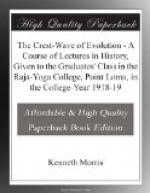All through the long West-Asian pralaya,—West-Asian includes Egyptian,—the seeds of the Esoteric Wisdom remained in those parts; they lacked vitalization, because the world-currents were not playing there then; but they survived in Egypt from the Egyptian Mysteries of old; and as in India you might have found men who knew about them, but not how to use them for the uplifting of the world,—so doubtless you should have found such men in Egypt during the Ptolemaic and Roman periods. Hence the statement of Diogenes Laertius, that the Theosophy of Ammonius Saccas originated with one Pot Ammun, a priest of Ptolemaic times: who, perhaps, was one of those who transmitted the doctrine in secret. The seeds were there, then; and how that the Crest Wave was coming back to West Asia, it was possible for Ammonius to quicken them; and this he did. But it had not quite come back; so he made nothing public. He wrote nothing; he had his circle of disciples, and what he taught is to be know from them. Among them was Origen, who was born, or became, a Christian; but who introduced into, or emphasized in, his Christianity much sound Theosophical teaching; very likely he was deputed to capture Christianity, or some part of it, for truth. Here I may offer a little explanation of something that may have puzzled some of us: it will be remembered that Mr. Judge says somewhere that Reincarnation was condemned by the Council of Constantinople; and that in a series of learned articles which appeared in THE THEOSOPHICAL PATH recently, the late Rev. S.J. Neill contradicted this asserion. The truth seems to be this: Origen taught, if not Reincarnation, at least the pre-existence of souls; and, says the Encyclopaedia Britannica: “It is true that many scholars deny that Origen [read, his teachings] was condemned by this council [of Constantinople, A.D. 553]; but Moller rightly holds that the condemnation is proved.”




